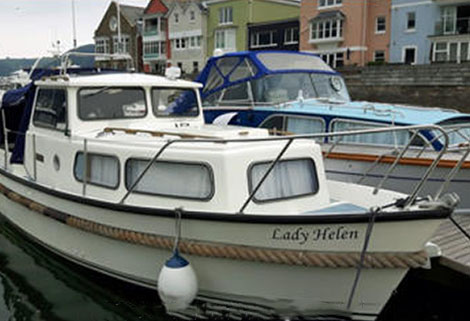With technology and engineering evolving at such an alarming rate, spare a thought for the humble bridge. How many people have crossed bridges across the globe without giving it a second thought?
With the brand new three tier interlocking glass bending bridge, the Ruyi Bridge opening in China, we started to think about how many famous bridges people could name.
Starting with the new Ruyi Bridge, which was planned back in 2017, and has finally opened after some scepticism regarding its wonky walkways, shortage of handrails and glass surrounds which seemed unrealistic.
Luckily the tourists seem to like it though, although some are not quite sure about the design, with many asking why there is a lack of handrails?
Spanning a stunning 328 feet (100 m) and a mind blowing 459 feet (140 m) above the ground, it is certainly not for the fainthearted, but has still managed to attract over 200,000 visitors since it first opened in 2020.
The bending bridge which boasts views over the Zhejiang Province has certainly got tourists speaking, some saying that they thought it was fake before actually seeing it in person, whilst others are totally amazed at the design of the structure.
The bridge design is inspired by a jade Ruyi, which is a carved object used as a symbol of good fortune in China. The creators explained that the design is intertwined into an undulating bridge body that gives an experience of walking on air when you pass over the glass floors. The rigid and soft shape design blends perfectly into the natural landscape, just like a jade Ruyi in the sky.
Footage of the bending bridge went viral on social media recently after the Canadian astronaut Chris Hadfield posted an eye opening video of the bridge from space.

The Ruyi Bridge in China with its glass floors
China seems to be at the centre of amazement when it comes to bridges, with another example being the home to the worlds longest and highest bridge in the world, measuring at an astonishing 19.9 miles. The China Sutong Jiang highway bridge has to be seen to be believed.
Connecting Nantong and Changshu, a satellite city of Suzhou, which is a province of Jiangsu, with a span of 1,088 m, it is a cabled style bridge with the largest main span in the world as of 2010.
There have been a number of significant bridges over the years that have transformed the way people travel, for either work or leisure. Some bridges have completely transformed communities, some have been a matter of life and death when the supplying of essential goods to the people on either side of various islands is taken into consideration.
We at Bearingtech can fully appreciate the dedication and engineering skills that make these magnificent structures worthwhile; the engineering capacity and knowledge is second to none, so we have decided to list a few to highlight the importance of the humble bridge.
The Golden Gate Bridge – San Francisco – USA
Opened to the public in in 1937 after only taking 4 years to complete, the bridge has quickly established itself as one of the most recognisable bridges in the world.
Before the bridge was built, beginning in 1820, the people of San Francisco had to travel to Marin Country by boat. The boat carried passengers and cars for over 100 years, before the bridge opened. One of the strangest things that the bridge incorporated was the use of a safety net, which managed to catch any unlucky worker who fell off the structure whilst working. Unfortunately this was only put in place after 11 people lost their lives, but for 19 the net proved life saving, having saved them from a watery death.
At one point the bridge had the largest span in the world, and considering the span of the China Sutong Bridge at 19.9 miles, the Golden Gate seems relatively small.
Sydney Harbour Bridge - Sydney – Australia

Sydney Harbour Bridge at dusk
The first instance of the iconic bridge history can be traced back to 1815. It was the first time that a proposal to connect the North and South shores surfaced when architect Frances Greenway proposed the plan. Fellow architect Robert Brindley put forward the idea of a floating bridge back in 1840, which was refused, but it was Peter Henderson who was the first person who put the first known drawing of the proposed bridge across the harbour.
The building of the bridge was seen as a saviour for the depression hit workers at the time. The 1400 worker`s who helped to build the structure, found the employment a huge sigh of relief, as jobs were hard to come by as the country was going through tough economic hardship.
Although climbing the bridge is illegal, they do offer guided tours to tourists, if you are lucky enough to be a celebrity you can get the opportunity to climb to the very top of the bridge, one such celebrity was Billy Connolly who had the pleasure of viewing the city from the very top during a recording of one of his tours and described the experience as incredible.
Brooklyn Bridge – New York – USA
Being one of the most iconic structures in America, you would think that any prospective buyers would need to talk to the state of New York or the Government in general, oh no, this is not the case, one of the most interesting facts about the bridge is the amount of times it has been sold by scammers who have tried to sell the bridge to unsuspecting buyers. One of the most renowned conmen was George C. Parker who sold the bridge many times over, only for the new owners to turn up and try and put toll booths in place, only to be told by the police that the bridge is not for sale and that they had been duped.
The bridge opened in May 1883, took 14 years to complete and was designated as a national monument in 1964. For the first 5 days of its life it was only used for leisure, however after a woman tripped over and caused a major panic with a rumoured stampede, which resulted in 2 deaths and 36 injuries, the bridge was soon changed to traffic only.

New York skyline behind the Brooklyn Bridge
Apart from being just a bridge, vaults were installed for storing large quantities of stock, most notable was the storage of wine, which could be stored in a cool temperature due to the river.
At over 50 foot tall and made of solid granite, they were perfect for cooling all types of alcohol and wine to name a few.
Another interesting story involved one of the new landlords of the bridges offices, the new tenant’s decided to have a clear out and threw away thousands of baseball bubble gum cards, that were not seen as valuable at the time, one of the cards sold for $500,000 dollars a few years later, how wonderful is hindsight?
It remains as one of the most iconic landmarks of New York and is a major tourist attraction alongside the Statue of Liberty and the New York skyline.
Millennium Bridge – Gateshead – Newcastle
Spanning the river Tyne, the bridge is one of 7 in Newcastle upon Tyne, connecting the Gateshead arts quarter on the south bank to the quayside on the Newcastle north bank.
The unique design has become one of the most remarkable landmarks in the area because of the way it opens and closes due to the shape and method of the tilting structure, which resembles a winking eye. Unlike the Brooklyn Bridge, it is only open to pedestrians and cyclists.
Built at the turn of the Millennium, it was part of a series of planned structures to celebrate the forthcoming era, structures like the London Eye and the Millennium Dome had the same idea.
Tsing Ma Bridge Hong Kong – China

Tsing Ma Bridge at night, Hong Kong
The Tsing Ma Bridge in Hong Kong is the world`s 14th longest span suspension bridge, and was the 2nd longest at the time of its completion. Named after the two islands that connect it, the bridge has two decks and carries both road and rail traffic.
The span of 1377 m (4518 ft), and height of 206 m (676 ft), making it the largest of all bridges carrying rail traffic.
The bridge decks carries 3 lanes of traffic in each direction, the lower one contains two rail tracks and two sheltered carriageway`s which are used for maintenance access and traffic lanes when the weather is bad especially when severe typhoons hit the city.
Classed as one of the most beautiful bridges in the world, it was opened in 1997 by British Prime Minister Margaret Thatcher at a cost of $1.35 billion dollars.
The Akashi –Kaikyo Bridge – Akashi – Japan
The Akashi Bridge is also referred to as the Pearl Bridge and is a suspension design that crosses the Akashi strait in Japan. Located to the south of the city of Kobe and the east of Osaka.
The waters around the strait are important fishing areas for local fishermen , and is also an important point to reach the Pacific ocean from the Seto Inland sea, making it one of the busiest straits in Japan.
The bridge pretty much killed the ferry industry in the area, which was the main passageway for travellers from island to island. The Akashi area is prone to severe storms, something which has resulted in multiple accidents over the years, one of which was the Shiun Main disaster of 1955 which cost the lives of 168 people, the incident confirmed to the Japanese Government that the bridge needed to be constructed.
Apart from the severe storms, Akashi is in an earthquake zone, which was a significant factor in the bridges construction, at the final count, 350,000 tonnes of concrete was used alongside 300,000 kilometers of cable enabling the bridge to withstand earthquakes up to 8.5 on the Richter scale and expand to 6 m a day if necessary.
Tower Bridge – London – England
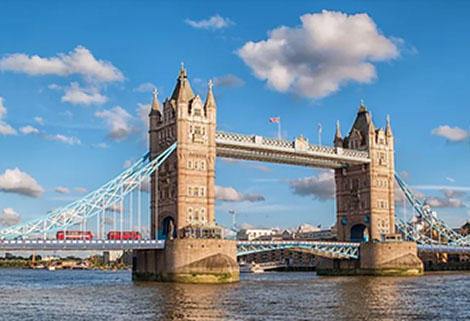
Tower Bridge, London - not as old as you would think!
Seen as one of the most iconic landmarks in England, Tower Bridge started its life as a competition experiment which was commissioned by the Special Bridge Committee who asked the public to design a bridge to cross the Thames, after 50 designs were submitted, none were approved and it was not until architect Sir Horace Jones and engineer Sir John Wolfe Barry put forward drawings which were eventually accepted.
Unfortunately Sir Horace did not see the fruition of his work having died a year before the bridge was completed. Built in 1886 the bridge was built to look much older than it actually was, the design was to blend in with the Tower of London which was built around 1066.
It took over 1000 workers to complete the build over a period of 8 years, even though the original estimate was only 4 years. During the construction 8 people lost their lives, which seemed to be the norm when constructing a bridge, as other projects across the world suffered the same fate.
The original cost was £1 million and was funded by a committee rather than public money, which would have caused a storm back in the 1800`s.
One of the best known parts of the bridge is the raised drawbridges which are called Bascules, which is a French word for see- saw, it is considered good luck to see the bascules being raised.
The bridge is an extremely sophisticated feat of engineering, simply because its construction is complicated. When first opened, steam was used to raise the enormous pumping engines, which turned the hydraulics and raised the bascules.
The system was upgraded in 1976 to oil and electricity due to the advancement in technology and engineering and proved a lot easier.
One of the funniest and unusual stories came in 1952 when a double decker bus actually jumped the bridge after the driver Albert Gunter realized that the bridge was opening and decided to go for it, he put his foot on the accelerator and sped towards the opening and jumped the gap and landed on the other side, his employers were so impressed by his bravery that they gave him the day off and gave him a £10.00 bonus for his efforts.
Many people confuse Tower Bridge with London Bridge, the most famous tale comes from the 1960`s when London Bridge had fallen into disrepair and London council decided to auction it off before starting work on a new bridge.
Enter the Lake Havasu City founder member who`d thought that he would buy it and reconstruct it for a tourist attraction back in the USA.
He paid $2.4 million, and had the bridge dismantled and the 10,276 granite blocks shipped to America. There are lots of urban legends that suggest he thought he was buying Tower Bridge, whether this is true nobody knows, except maybe the Lake Havasu member.
Millau Viaduct Bridge – Tarn Valley – France
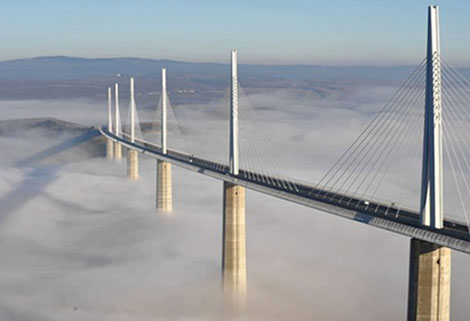
The Wonderful Millau Bridge in France that sits amongst the clouds.
Standing at a staggering 343 m (1125 ft ) the Millau Bridge sits amongst the clouds like something out of a sci-fi film, and certainly deserves the title of Europe`s tallest bridge, as would anything that is taller than the Eiffel Tower.
Designed by renowned British architect Norman Foster and French structural engineer Michel Virlogeux and was completed in 2004 at a cost of €394 million.
Spanning the Tarn Valley the bridge was designed to ease the heavy traffic en route from Paris to Spain in the holiday season, which caused major congestion, and after numerous complaints from the travellers and local residents the decision to commission the bridge was made in 1991.
Due to the design of the bridge, constructing it was an enormous challenge. Starting with the deep foundations, which had to support the massive structure on 7 pillars, each weighing 700 tonnes, which had to be specially built.
Because of the height and weight of the bridge, satellite pinpoint accuracy was used to place each piece in exactly the right position. After the pillars were placed, two decks were slid on top from each end. Despite the two ends of the bridge being at different heights and with a slight curve, the two decks were aligned within 1 centimeter of each other, which is a remarkable feat of engineering. Due to the bridge being a toll road at €6.00, it has to be the best value for money especially when you consider the view.
Vasco da Gama Bridge – Lisbon – Portugal
The wonderfully curved bridge spans the Tagus River in Parque das Nacoes in Lisbon and was designed by the engineers to sit with the Earths natural curvature, making it an engineering masterpiece that can withstand winds of up to 155 mph and has a life expectancy of 120 years.
It is considered to be the longest bridge in the European Union and the second longest in Europe after the Crimean Bridge.
Construction began in 1995 by engineers from Portugal, France and Britain and was open for traffic in 1998, just in time for the Euro 98 World Trade Fair, which celebrated the discovery of the sea route from Europe to India by the explorer Vasco da Gama.
The $ 1.1 billion project was split into four parts, each being built separately by a different company and supervised by an independent consortium. The financing for the build was via a build operate & transfer system by Lusopante, who are a private financial company who will receive the toll payments for the first 40 years.
The bridge is a matter of national pride, not only due to the technical feats, but carried out the promise that was made to local residents by the Government to ease the congestion in the local area by linking the Sugunda Circular to the national trunk road and the future A12 motorway.
Khaju Bridge – Isfahan – Iran
Known as one of the oldest bridges from Iran`s historic past, the Khaju Bridge was built around 1650 under the reign of Abbas II, the seventh shah of Iran.
The bridge has 23 arches and is 133 metres long and was originally covered with paintings and tile-work and was used as a teahouse. It is often described as the city`s finest bridge.
There is also an interesting feature at the centre of its structure, still to this day you can see the remains of a stone throne which Abbas himself would have sat on admiring the view.
The bridge has several sluice gates under the archways, which allows the water flow needed to hydrate the Zayenderud area, when the gates are closed, the water level behind the bridge is raised to facilitate the irrigation of the many gardens along the river.
The upper levels of the bridge were utilised by horses and carts, which ran alongside vaulted pathways for pedestrians.
Arthur Pope who was an American expert on Persian art described the bridge as the culminating monument of Persian bridge architecture that combines consistency, utility, beauty and recreation. So much so was his love for the structure, after his death he was laid to rest nearby.
Forth Bridge - South and North Queensferry –Scotland

Forth Bridge in Scotland
Designed by John Fowler and Benjamin Baker in 1882 the Forth Bridge was officially opened in 1890 and was considered an exceptional piece of Victorian engineering and was a pioneering build at the time of its construction. Now recognised as a UNESCO World Heritage site, the bridge has appeared on bank notes and coins and is considered a significant symbol of Scottish culture.
At the height of its construction more than 4000 men were employed over the duration, during this time 57 lost their lives by accidents.
With a span of 2467 m ( 8093 feet ) and a height of 137 m (449 feet) the construction resulted in an unbroken route from London to Aberdeen.
The design consisted of 53,000 tonnes of steel held in place buy 6.5 million rivets, alongside piers, that were built using 120,000 cubic yards of concrete and masonry.
Unfortunately due to the steel design the bridge has to be painted to upkeep its appearance and uses an estimated 240,000 litres` of paint.
The bridge is in constant use with 200 trains travelling across it a day and carrying 3 million passengers a year.
The Bridge of Sighs – Venice – Italy
The Bridge of Sighs crosses the Rio del Palazzo and is one of 400 bridges that cross many of the 100 canals that run through Venice.
Located in the south of the city and just east of St Marks Square and the St Marks Basilica, which is one of the most famous parts of the city.
The bridge connects the famous Doges Palace to the new prison, Prigoni Nuove, and leads the interrogation room direct to the Palace.
Construction of the structure started in 1600 and was completed 3 years later, making it one of the oldest bridges in Venice.
It is believed that by the time of the inquisition and subsequent executions had long passed by the time the bridge was built, and it was only small time criminals who actually walked across it.
One of the most famous people to suffer the walk of shame was no other than historical Romeo Giacomo Casanova who once arrested for an affront of religion and common decency, and was sentenced to 5 years on the top floor of the prison, he eventually escaped after 18 months with the help of a monk, which is ironic as the charge involved religion.
Szechenyi Chain Bridge – Budapest – Hungary
Opened in 1849, the Chain Bridge became the first permanent bridge in Hungary.
Designed by English engineer William Tierney Clark and built by Scottish engineer Adam Clarke, the bridge was designed to cross the river Danube between Buda and Pest.
At the time of its construction it was regarded as one of the modern wonders of the world, and seen as an advancement linking between the East and West.
Once built it was significant in growing the economy, improving social and cultural lives.
Confederation Bridge – Prince Edward Island & New Brunswick – Canada
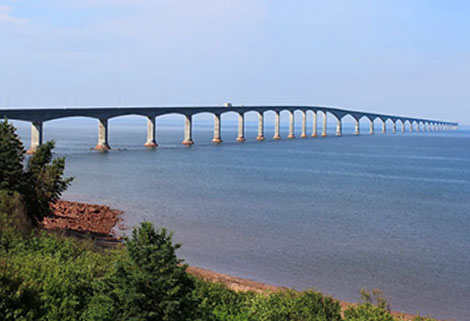
Confederation Bridge, Canada
Built at a cost of $ 1.3 billion dollars in 1997, the Confederation Bridge was designed to connect islands of Prince Edward and New Brunswick.
The construction was built with 62 massive piers, which elevate the road structure above. Once you get onto the bridge you will need to pay a toll fee if you are using a motor vehicle. Pedestrians and cyclists are not allowed to walk on the bridge and need to use the shuttle service which also has a fee, like most ventures they normally start off with free access but over time develop a payment method that is passed onto the communities.
Once opened, one of the first events to be held was a massive walk attended by 75,000 walkers.
Rialto Bridge – Venice – Italy
Constructed between 1588 –1591, the bridge is one of the main four bridges to cross the Grand Canal, and one of the oldest in Venice.
Originally called the Ponte Delta Moneta connected the Rialto market, which became one of the most popular markets in Venice in the 13th century.
The floating bridge that was in place at the time saw a massive influx of traffic, which it could not sustain and was subsequently replaced by a wooden structure, which was much wider and stronger.
The wooden version of the Rialto Bridge was a medieval design similar to Tower Bridge, allowing ships to pass underneath.
Due to the increased amount of traffic that crossed the bridge, merchants seized the opportunity of making more money by installing rows of shops to attract customers. In order to benefit from this unique location, the merchants had to pay the State Treasury rent for the privilege.
Unfortunately as with most structures, there are always occasions and events that are not happy, the Rialto Bridge is no exception, with multiple accidents and mishaps, and apart from collapsing many times, it was completely burnt out in a revolt in 1310.
Having had the benefit of the merchant`s shops across the bridge, proved to be an economic lifeline, with the rent paying for the reconstruction and maintenance of the new bridge.
The wooden bridge was eventually replaced by the stone version in 1588 after original requests had been submitted to the authorities back in 1503.
Once the stone bridge was commissioned, there were plenty of architects and designers who put forward plans and drawings, one being from Michelangelo, which was rejected. The final approval was given to a Venetian architect called Antonio da Ponte who was also responsible for one of the other famous Venice landmarks, the Doges Palace, he managed to beat off several well known players to claim the commission.
There was some opposition to the design, many saying that the bridge would end up in ruins due to the pressure on its foundations, however they did not collapse and is still standing proud hundreds of years later.
Siosepol Bridge – Isfahan – Iran
Siosepol Bridge is a double deck arch bridge based in Isfahan in Iran. The name means 33 bridges or bridge of arches and is considered to be Iran`s largest construction on water.
The bridge has a large plane at the beginning of the construction where the Zayandeh river flows at its fastest.
There are two levels of arches, the lower level has 33 whilst the top level has two, alongside a road which has bounded high walls to protect travellers from high winds and also to stop pedestrians from falling off.
Stari Most Bridge – Bosnia
There is a local legend that Stari Most Bridge was held together with metal pins and egg whites, and to this day remains an unusual yet impressive design.
The bridge was commissioned by one of the most famous Ottoman Sultans, Suleiman the Magnificent in the 16th century.
Before the commission the old bridge was a swaying wooden bridge that pedestrians would use at their peril and fear for their lives as they crossed the rickety wooden planks.
It is said that on the day of the unveiling of the new bridge to the sultan, the architect Mimar Hayruddin was preparing his funeral shroud as he was convinced the structure would collapse once the scaffolding was removed, which would leave him out of favour with the Sultan.
On a happier note, one of the world`s oldest diving competitions takes place every year from this iconic UNESCO World Heritage site.
Young men jump from the apex in a ritual that signals their transition into manhood, but not everyone can take part, according to competition rules, all competitors must have the proper training for the event which dates back hundreds of years.
Great Belt Bridge – Zealand & Funen – Denmark
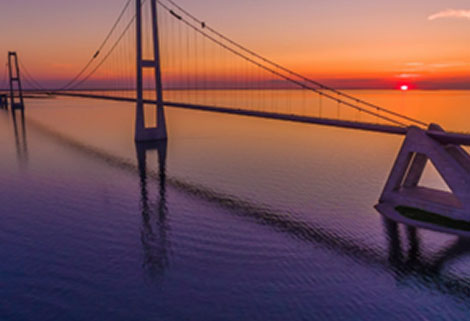
The Great Belt Bridge is the largest structure in Denmark
Before the bridge was built in 1991-1998, some 8,000 cars had to use a ferry service to cross the Great Belt River. After the construction, 30,000 vehicles used the bridge every day, saving an enormous amount of time. By the time you waited in line for the ferry and the actual time of the crossing, you were looking at around 90 minutes compared to the 15 minute journey to cross the bridge by car.
The bridge connects Zealand and Funen and is the world`s 5th largest spanning bridge outside Asia.
The bridge was finally agreed after 50 years of debate by the Danish Government in 1986 and on time of completion cost 21.4 billion Danish Krona resulting in Denmark`s largest construction project in Danish history.
Ponte Vecchio – Florence – Italy
Listed as one of the most iconic bridges in the world, the Ponte Vecchio is a wonderful landmark in Florence Italy.
Its name translates to Old Bridge and like the Ponte Rialto Bridge in Venice , it has shops built on it, which was seen as normal in medieval times, but not so much in the modern era. Spanning the 2nd most famous river in Italy after the Tiber, the Arno flows through Arezzo, Florence, Empoli and Pisa.

Ponte Vecchio, Florence
The Ponte Vecchio is one of the oldest bridges in Italy, as it was first mentioned in documents dating back to 996, this makes sense as the Romans were already building piers made out of stone at this time in history.
The fact that the bridge is seen as “Old”, the bridge today is not the original design, having been destroyed multiple times, it was finally reconstructed and built in stone in 1345 by the Italian historian Taddeo Gadd.
During World War II, all the bridges were destroyed by the German army, on the orders of Adolf Hitler, to try and stop the advancement of the British 8th army who were making their way into Florence in 1944.
The story goes that he visited the Ponte Vecchio on a previous visit as a guest of Mussolini, and was so taken by the view from the bridge that he ordered the structure to be left intact.
Shame he didn’t visit all the other cities and architecture he destroyed as well.
Alcantara – Extremadera – Spain
The Alcantara Bridge is a stone arch bridge spanning the river Tagus and was built between 104-106 CE on the order of the Roman Emperor Trajan from 98 CE.
During its time the bridge has been destroyed more times by the effects of war than weather. In 1214, the Moors destroyed the smallest arch, which was rebuilt in 1543 using materials from the quarries that were sourced for the original design.
The Spanish destroyed the second arch on the right twice, first in 1760 to prevent the Portuguese from invading, and secondly in 1809, during the war between Spain and France the bridge was blown to cut off French troops.
In 1890 Queen Isabel II used mortared masonry instead of the temporary repairs and fixed the bridge, allowing the structure to still be intact today.
Summary
Bridges have grown steadily over the years, spanning vast amounts of water, connecting towns, cities and even countries.
From its humble beginnings of a footbridge to the amazing Millau Bridge high amongst the clouds, bridges are getting higher, larger, wider and more elaborate.
A structure that started out as a simple means of support for people going about their normal day- to - day duties, turned out to be a life saver, a deterrent and means of prosperity.
One thing for is for sure, if there is a body of water or hills and mountains to cross, humans will try and brace it with a bridge for whatever reason.
As far as bridges go, they are never too far!
 This edition of intertidal zone is the often-present interaction between the road system and the canal and river systems (and nature).
This edition of intertidal zone is the often-present interaction between the road system and the canal and river systems (and nature).

 There are visitor moorings adjacent to the bridge (1 day) and you will see from the signposts that you can walk or cycle into nearby towns and sights. A private sign on the fence advises of a pub within 5 minutes’ walk. Next to the bridge, for those who may wish to meet up with land-based folks, there are 2 car parks.
There are visitor moorings adjacent to the bridge (1 day) and you will see from the signposts that you can walk or cycle into nearby towns and sights. A private sign on the fence advises of a pub within 5 minutes’ walk. Next to the bridge, for those who may wish to meet up with land-based folks, there are 2 car parks.

 By 2015, street corners themselves were closing: proliferating
By 2015, street corners themselves were closing: proliferating  How do you harness that energy? How do you put together the world’s largest collection of aspiring performers with discriminating audiences? In compliance with Canal and River Trust rules that limit you to audiences of 12 and acoustic music? And post-Covid, how do you do it on a scale that addresses the fact that venues which successfully evaded gentrification remain shuttered? And will be shuttered again, as a first precaution authorities take when a novel virus next spreads?
How do you harness that energy? How do you put together the world’s largest collection of aspiring performers with discriminating audiences? In compliance with Canal and River Trust rules that limit you to audiences of 12 and acoustic music? And post-Covid, how do you do it on a scale that addresses the fact that venues which successfully evaded gentrification remain shuttered? And will be shuttered again, as a first precaution authorities take when a novel virus next spreads?
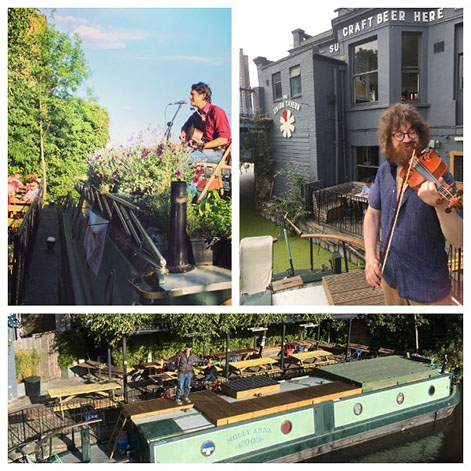
 It’s the first manifestation of Brigadoon!, with a handful of boats, that we expect to grow in number as we roll onto the next event a week later, and one a week after that. Each one reflecting the character of the neighbourhood. Each one requiring agreements between local Borough officials, CRT and Met Police. Each one leaving a template of risk assessments and Covid-precautions for other canal boat owners, roving traders and performers to jump start discussion with with local officials. Who this time, will already know what you’re trying to do.
It’s the first manifestation of Brigadoon!, with a handful of boats, that we expect to grow in number as we roll onto the next event a week later, and one a week after that. Each one reflecting the character of the neighbourhood. Each one requiring agreements between local Borough officials, CRT and Met Police. Each one leaving a template of risk assessments and Covid-precautions for other canal boat owners, roving traders and performers to jump start discussion with with local officials. Who this time, will already know what you’re trying to do.  And what days they were, eh?
And what days they were, eh? We blamed the Chinese, completely forgetting that Ozzie Osborn had been stuffing raw bat down his neck with no ill effects for years, watched in awe as Donald Trump eclipsed even the efforts of Boris, our own resident buffoon and completely forgot that we were supposed to be blaming him for Brexit.
We blamed the Chinese, completely forgetting that Ozzie Osborn had been stuffing raw bat down his neck with no ill effects for years, watched in awe as Donald Trump eclipsed even the efforts of Boris, our own resident buffoon and completely forgot that we were supposed to be blaming him for Brexit. In a dazzling move, which stunned the world and certainly the EU who we’d recently left although no one had noticed, we developed a vaccine.
In a dazzling move, which stunned the world and certainly the EU who we’d recently left although no one had noticed, we developed a vaccine. In December 2001, Time Magazine featured the Cobb as one of the best inventions of that year. This was a major turning point for what had started out as an obvious idea to an environmentalist in Africa several years earlier.
In December 2001, Time Magazine featured the Cobb as one of the best inventions of that year. This was a major turning point for what had started out as an obvious idea to an environmentalist in Africa several years earlier.
 The Cobb is virtually smokeless, since the fat and oil drain away and not onto the fire. The base always remains cool-to-touch on the outside whilst cooking hot on the inside.
The Cobb is virtually smokeless, since the fat and oil drain away and not onto the fire. The base always remains cool-to-touch on the outside whilst cooking hot on the inside. the elements that make up Cobb...
the elements that make up Cobb... awards...
awards...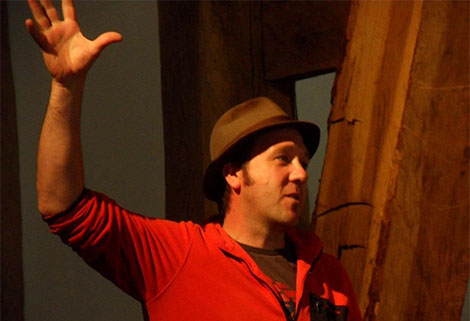 So I’ve been a storyteller for about 24 years. I work all over the British isles at festivals and events and in schools, colleges and universities. Originally, I was a street theatre performer, fire breather and stilt walker.
So I’ve been a storyteller for about 24 years. I work all over the British isles at festivals and events and in schools, colleges and universities. Originally, I was a street theatre performer, fire breather and stilt walker. I currently live aboard Narrowboat Hawker (that features in the book) with my Wife Jo who is a puppeteer. We often have people on board for stories and shadow shows.
I currently live aboard Narrowboat Hawker (that features in the book) with my Wife Jo who is a puppeteer. We often have people on board for stories and shadow shows.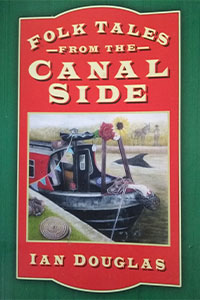 'Folk Tales from the Canal side' is one of those beautiful little books that grab you from the moment you see it. It is a nice size, easy to hold and easy to flick through. The front cover is enticing. The colours are those of a traditional canal boat, and the inset painting shows many things associated with boating, or with tales of boating: but a man with a donkey? and a whale?
'Folk Tales from the Canal side' is one of those beautiful little books that grab you from the moment you see it. It is a nice size, easy to hold and easy to flick through. The front cover is enticing. The colours are those of a traditional canal boat, and the inset painting shows many things associated with boating, or with tales of boating: but a man with a donkey? and a whale?
 Generically known as the ‘Norfolk Broads’ are the man-made rivers and lakes (Broads) of Norfolk.
Generically known as the ‘Norfolk Broads’ are the man-made rivers and lakes (Broads) of Norfolk.


 If you see a 55' purple boat with large cream flowers on, that is my gorgeous GillyFlower, so wave or stop by and say hello! My name is Peri
If you see a 55' purple boat with large cream flowers on, that is my gorgeous GillyFlower, so wave or stop by and say hello! My name is Peri










 Peri Pigott has been a liveaboard boater since 2014, and a floating trader for the last few years. She generally trades on the Gloucester and Sharpness Canal, but also sells through the internet, so don't be put off by distance!
Peri Pigott has been a liveaboard boater since 2014, and a floating trader for the last few years. She generally trades on the Gloucester and Sharpness Canal, but also sells through the internet, so don't be put off by distance!